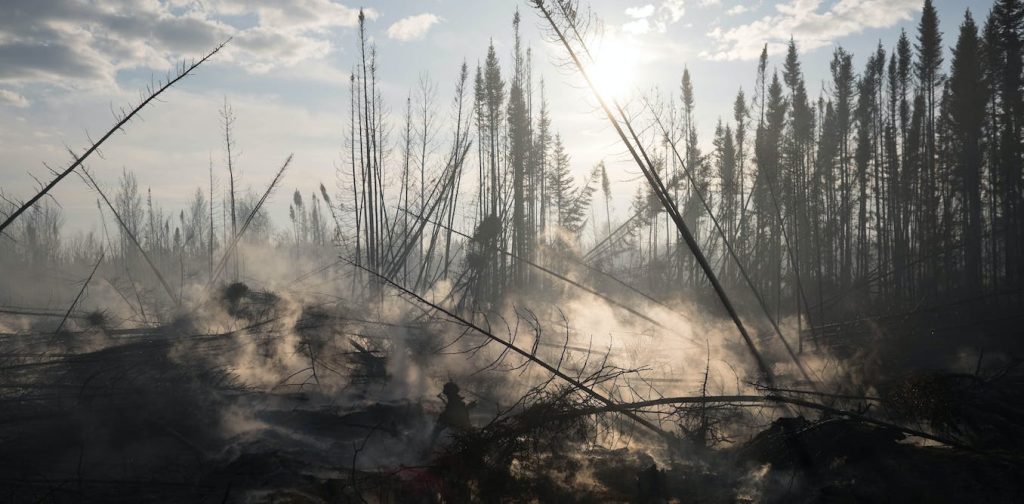For centuries, society has scorned bogs, fens and swamps — collectively known as peatlands — treating them as wastelands available to be drained and developed without realizing they’re important buffers against climate-changing carbon emissions.
It’s only recently that humans have realized how vital these wetlands are to regulating our climate, despite negative connotations in derisive expressions like “swamped,” “bogged down” and “drain the swamp.”
Draining the swamp, wherever it might be, could be a catastrophic mistake for humankind as climate change throws punches that these ecosystems can handle much better than others.
But as the changing climate exacerbates the extent of droughts and wildfires, especially in the vast peatlands of the north, these ecosystems are now fighting a losing battle.
Threats to carbon-sequestering peatlands
A majority of all the world’s peatlands are found in northern regions. Layered by waterlogged peat topped by living mosses, these peatlands absorb and expel carbon, typically storing a little more than they give off, making them carbon sinks over time. Over thousands of years, they have stockpiled massive amounts of carbon.
(Shutterstock)
Collectively, peatlands hold more carbon than all the world’s forests. Peatlands account for just three per cent of the world’s land mass but hold about a third of the planet’s stored soil carbon, making them Earth’s most carbon-dense ecosystems.
However, peatlands are under pressure everywhere. They are affected by rising temperatures, drought, wildfire and various human actions, including drainage. In this process of draining, the water from the peatlands is allowed to run off through dug-out ditches, thus making the wetland drier.
Individual bogs are drained for agriculture, mining, urban development, wind turbine placement or peat harvesting. So far, between seven and 10 per cent of all northern peatlands have been drained.
Fire and bogs
Wildfires are becoming more frequent and more severe, meaning peatlands will have to be at their best to continue absorbing carbon.
THE CANADIAN PRESS/Darryl Dyck
Healthy peatlands are remarkably resilient to the impacts of fire. A significant amount of carbon is lost both to burning itself and through burn damage that impairs the growth of carbon-sequestering mosses. But these ecosystems are typically able to recover and restore their climate-regulating function within 10 to 30 years.
However, when bogs have been damaged, especially by drainage, they become vulnerable to wildfire.
Even without fire, drained bogs are net contributors of carbon. When they burn, they burn much more deeply because their peat reserves are dry and dense. These self-propagating smouldering fires can spew millions of tonnes of carbon and harmful, toxic smoke into our atmosphere.
The time to save our peatlands is now
As climate change accelerates over the coming decades, the interplay between degraded peatlands and hotter fires significantly changes the carbon equation in the environment.
(Mike Waddington), Author provided
In our recently published paper, we found that the direct threat from drainage, coupled with climate-change enhanced wildfires, is accelerating the release of carbon from these peatlands. Simply put, our actions are turning climate-friendly peatlands into liabilities, with potentially devastating consequences.
Our study of natural, degraded and restored forms of peatlands in boreal and temperate regions revealed that the once stable carbon-storing power of our northern peatlands is gradually losing to the effects of fire, and drained peatlands are the biggest culprits for this.
Compromising the healthy peatlands that remain — even if it’s for otherwise beneficial uses such as growing food or helping us move away from fossil fuels — could backfire badly, especially as climatic conditions worsen.
(Greg Verkaik), Author provided
We found that without deliberate restoration efforts for already drained peatlands, and protection for those that remain, our carbon-collecting northern bogs could flip to carbon contributors by the end of this century. This will further accelerate the overall pace of global warming and climate change.
Fire is natural, of course, and some peat will always burn, but the degree and frequency of wildfire is making it harder for peatlands to recover their ability to store carbon after a fire.
Our research shows that it is not only critical to keep our peatlands from burning up, but that there is also an important and viable opportunity to mitigate this impending disaster. But the window for action is shrinking quickly.
Canada is home to one-third of the world’s northern peatlands and a proven force in restoring drained bogs.
The looming peat fire crisis demands that Canada prioritize protecting its intact peatlands and accelerate their restoration. Reviving the carbon-storing capacity of peatlands would delay their broader conversion from climate benefactors to liabilities, providing precious time to act on climate change.

